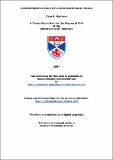Hydroformylation in fluorous biphasic media
Abstract
The hydroformylation of oct-1-ene is investigated under fluorous biphasic conditions, utilising the facile catalyst recovery that is provided by the temperature dependent miscibility of the perfluorinated solvent with normal organic solvents. High conversions and selectivities have been obtained in the batch process and the system is now described under continuous-flow conditions in a custom built reactor.
The continuous-flow reactor was successfully run for 46 hours, with conversions to nonanal of 60% and l:b ratios of approximately 10.
To understand the mechanism of this reaction more fully, a spectroscopic study of the catalyst formation and hydroformylation reaction was undertaken, using high-pressure infrared (HPIR) and nuclear magnetic resonance (HPNMR) techniques. The results of this study showed that although there is some effect of the strongly electron withdrawing nature of the perfluorinated ligand, the species formed under reaction conditions are very similar to those formed under the analogous triphenylphosphine system. It was found that under reaction conditions the perfluorinated ligand formed both the bis- and tris- phosphine complexes, compared to triphenylphosphine, which only formed the bis-phosphine complexes. The equatorial-equatorial and equatorial-axial isomers of [RhH(CO)₂(P(C₆H₄C₆F₁₃)₃)₂] were identified by means of a deuterium study in the HPIR spectrometer.
The low levels of phosphorus and rhodium leaching to the organic phase were attributed to the predominant formation of [RhH(CO)(P(C₆H₄C₆F₁₃)₃)₃] under ambient pressure and temperature (separator conditions) indicated by a well defined quartet in the metal hydride region of the ¹H NMR spectrum.
Type
Thesis, PhD Doctor of Philosophy
Rights
Creative Commons Attribution-NonCommercial-NoDerivs 3.0 Unported
http://creativecommons.org/licenses/by-nc-nd/3.0/
Collections
Except where otherwise noted within the work, this item's licence for re-use is described as Creative Commons Attribution-NonCommercial-NoDerivs 3.0 Unported
Items in the St Andrews Research Repository are protected by copyright, with all rights reserved, unless otherwise indicated.


